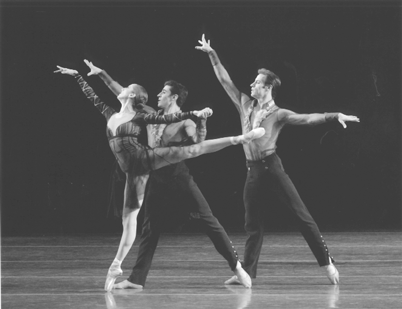Christopher Wheeldon’s breathtaking combinations evoke Balanchine
“There are no new steps, only new combinations,” said George Balanchine. His axiom lives on in New York City Ballet’s commitment to presenting new ballets. City Ballet’s 10th annual “New Combinations Evening” featured the world premiere of resident choreographer Christopher Wheeldon’s “Klavier” along with three Balanchine ballets at the New York State Theater on January 24.
“Klavier” is set to the third movement of Ludwig van Beethoven’s “Hammerklavier Piano Sonata No. 29 in B flat Major.” It is a 20-minute adagio and the dance is romantic, sexy, Goth. In Jean-Marc Puissant’s design, a crystal chandelier sits on the floor at the end of its chains, with swag reflecting in the dim purplish light. Penny Jacob’s lighting creates a warm dark atmosphere that sweeps us into the mood, like Ross Bleckner’s dark chandelier paintings. Cameron Grant’s gorgeous live piano also charged the atmosphere with drama Wheeldon’s “VIII” and his “Shambards” are dramatic. In his retro-Goth sensibility pain and love are not strangers. He evinces matters of life and death.
The perpetual and sweeping movement powerfully swayed the audience. There’s hardly a straight axis to anchor oneself to, nor any clue to “Klavier’s” direction. The after-hours whirlwind is as enchanted as a story ballet. The cast of ten wears silvery diaphanous material with emblematic colored bodices on the two ballerinas, Wendy Whelan in emerald and Miranda Weese in burgundy. Weese spins en l’air on Albert Evans’ raised arms. She is dragged on the floor with restraint. The dragging and sliding interestingly introduces gravity into the ballet. The two regal ballerinas stick together with perfectly timed sissonnes, supported by the men as they carry them off the stage.
Whelan and Sébastien Marcovici look meant to be. She enters grandly, sliding in to center stage. The two wrap curvilinear arms around each other’s personal space, not touching; caringly but with occasional abruptness suggesting angry impetus. Stage personality and subtle dramatic skill shine in Whelan’s able partner. In a duet, she grazes his face with her own in a suggested kiss that’s ripe with passion; but Whelan is joyful as she is seductive. Her sophisticated performance grounds the dance, touching the soul of every person.
A band of boys in black — Tyler Angle, Craig Hall, Andre Veyette, and Sean Suozzi—stand by Pauline Golbin and Melissa Barak. The women’s strong presence makes up for their short supply. They sit on pedestals of male courtiers.
To end, arms spring out to the side on first one dancer and then another, until all emerge like night flowers and we in the audience feel we’ve had a privileged viewing of some secret rite, a dreamlike dance.
For all its breathtaking beauty, “Klavier’s” stage romance is less defined; its logic less clear than Balanchine’s even more abstract “Movements for Piano and Orchestra.” In that dance, two trios of women in lovely neoclassical formations flank Darci Kistler’s more difficult combinations. She is partnered by Charles Askegard; his confident understatement makes him a spectacular Balanchine envoy. We know what Kistler/Askegard are doing and why. They present this with “Monumentum Pro Gesualdo,” both short pieces to Stravinsky, in simple black and white dress, which began the “New Combinations Evening.”
Balanchine’s “Symphony in C” to Georges Bizet was last; the elegant classic that also concluded the very first City Ballet concert in 1948. Sofiane Sylve and Askegard, man of the evening, danced the beautiful “Second Movement: Adagio” in which Sylve is pushed up by Askegard and easily floats across the stage. As she trustingly falls, her man is always there.
Megan Fairchild and Joachim Luz lead in the Third Movement, a youthful allegro vivace. He’s a character, boundlessly leaping and crossing in front of her — and she is appreciative. Both perform with a childlike exuberance. In the Fourth Movement: Allegro Vivace, Sylve/Askegard’s brief duet uplifts with its musicality and vitality. Abi Stafford holds her own in the ballerina’s excellent pas de quatre.
gaycitynews.com



































